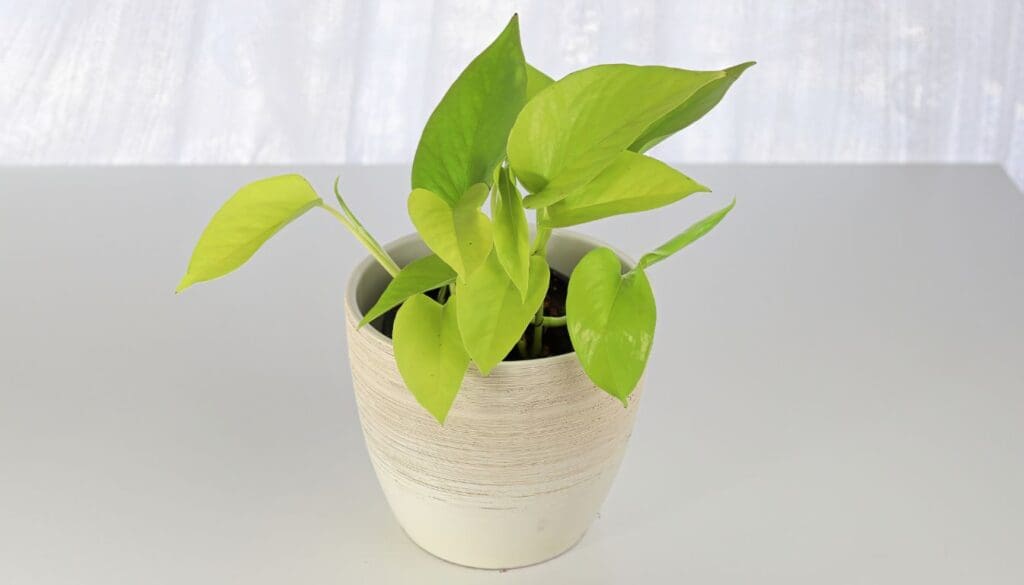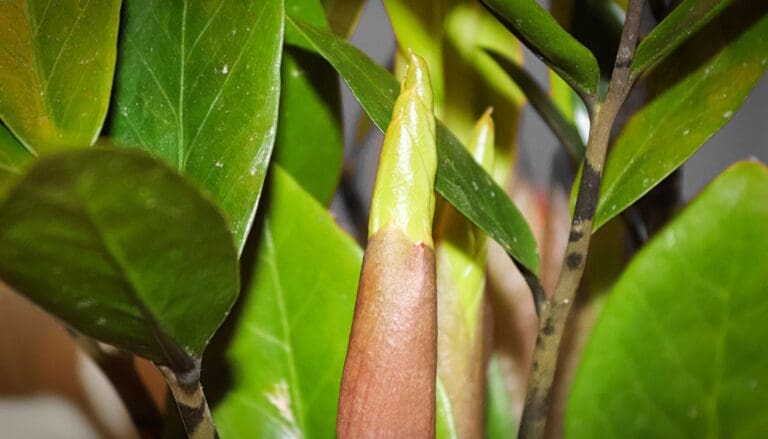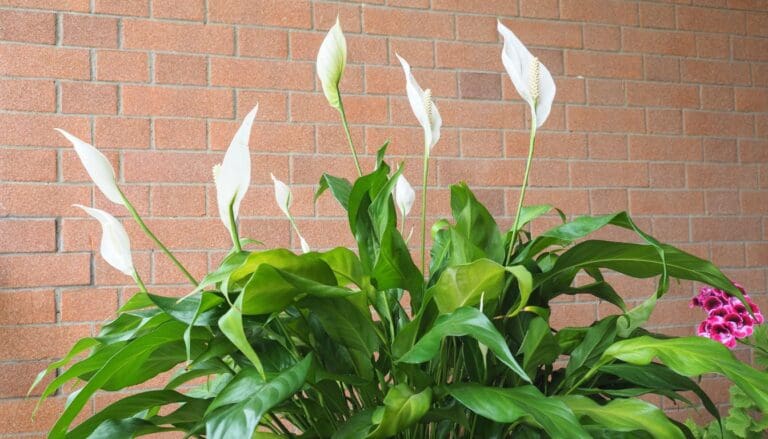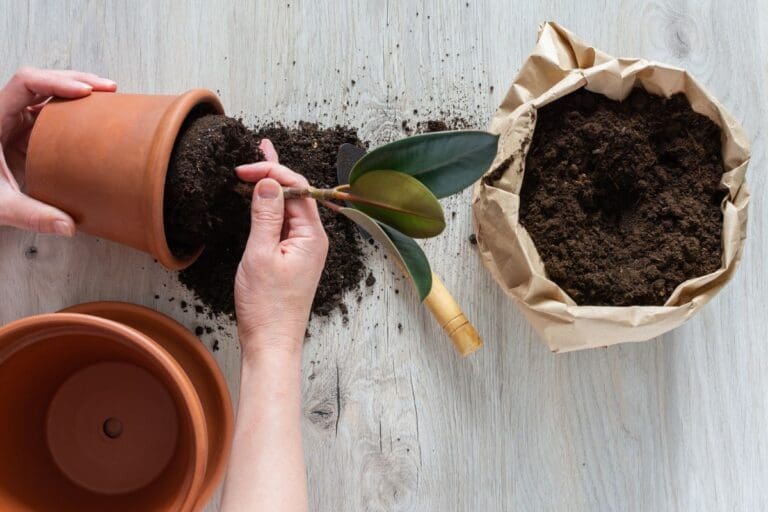Root Rot In Pothos: Signs, Causes, How To Fix & More
Root rot is one of the most common yet worst things that could happen to Pothos. The plant’s heart-shaped leaves and trailing vines can decorate any house corner. But once root rot sets in, it becomes challenging to save the plant.
Excess moisture, large pots, watering during the cold or dormancy, and pathogens cause root rot in Pothos. Signs include wilting, yellowing, mushy parts, and foul smell. Repotting can help; otherwise, collect healthy cuttings from your Pothos for propagation.
Are your Pothos suffering root rot, and you don’t know what to do? Read this article till the end to explore the signs, causes, and treatment for root rot in Pothos. We will also provide helpful tips on preventing root rot from reoccurrence.

Please note: Simplify Plants is reader-supported. As an Amazon Associate, I earn from qualifying purchases made by our readers with no extra cost added to you all! Some links in the post are affiliate links and I get a commission from purchases made through links in the post.
7 signs of Root rot in Pothos
When root rot has set in your Pothos and progresses, it will show some telltale signs.
You must recognize these signs to confirm root rot and provide the correct treatment.
Misdiagnosing can cause other issues.
1. Wilted leaves in Pothos
If Pothos roots are damaged, it hinders the smooth transfer of moisture and nutrients.
Hence, the leaves will wilt when they don’t receive proper moisture or nutrients due to stress.
2. Pothos have yellow or brown leaves
When the Pothos leaves do not get enough moisture or nutrients, chlorophyll production (responsible for leaf pigment) is restricted.
For this, the leaves will become yellow or brown over time.
3. Pothos are not growing
Pothos cannot grow appropriately since the moisture and nutrient uptake get disturbed due to rotten roots.
Pothos will either have a slow growth or stop growth.
4. Brown spots on the Pothos leaves
When pathogens reach the wet soil of your Pothos, you will notice brown spots, indicating that root rot has set in your plant and progressed.
5. Leaves falling off from your Pothos
With so much stress, Pothos loses energy to hold the leaves, causing defoliation.
Primarily, the discolored and spotted leaves are the first ones to fall off.
Gradually, the good green leaves will also begin to fall off.
6. Pothos stems and roots are mushy
If you inspect a bit more, you will find the stems of your Pothos close to the soil to be very mushy.
Examine the roots, and you will see them as brown and mushy.
7. Pothos soil has mold and is releasing a foul smell
When the Pothos soil stays wet for too long, mold and mildew will develop.
While inspecting the roots and stems, you will receive a foul smell from the soil and roots.
The disease has progressed too much at this stage.
6 causes of Root rot in Pothos plants

You know how to treat root rot in Pothos. But what causes the issue? Let’s understand.
1. Overwatering Pothos can cause root rot
Overwatering Pothos without letting the soil dry causes waterlogging.
It suffocates the roots and inhibits moisture and nutrient uptake.
Over time, the roots will rot while staying wet for too long and not getting a chance to dry out, leading to root rot.
2. Drainage issues in Pothos lead to root rot
Drainage is the issue if your Pothos soil is wet despite proper watering schedule and frequency.
In poorly drained soil, water stagnates, reducing oxygen and suffocating the roots.
This prolonged wetness eventually leads to root rot
Another thing to consider is the pot. A pot without drainage holes also retains the extra water.
Again, the roots sit in water and begin to rot over time.
3. Watering Pothos in cold temperatures and high humidity can result in root rot
Pothos prefer warm temperatures ranging between 65-90°F, and it will readily absorb the moisture and nutrients you give.
But Pothos struggles to absorb moisture during low temperatures, especially during the fall and early spring.
The soil remains damp for extended periods at these times, and watering like summer will make the soil soggy.
Roots will sit in water and start rotting after some time.
High humidity doesn’t necessarily cause root rot.
But, if you water your Pothos without letting the soil dry, excessive moisture and high humidity together cause root rot faster.
4. Pothos in oversized pots can lead to root rot
When Pothos grows in a big pot, the roots get enough room to grow.
But the big pot contains more soil that holds a lot of moisture and takes time to dry out.
The roots, too, stay wet and start rotting.
5. Watering a dormant Pothos can cause root rot
Pothos go dormant in winter and don’t support new growth.
Hence, it won’t need frequent watering.
However, hydration is needed, and you cannot entirely stop watering.
You need to water Pothos less frequently to maintain hydration.
Even a bit of excess water can lead to root rot.
6. Root rot pathogens causing fungal infections in Pothos
Fungi like Phytophthora, Rhizoctonia solani, and Pythium thrive and multiply faster in wet conditions.
These fungi get attracted to your Pothos due to high moisture levels can cause root rot infection.
The fungal spores can also get spread through the soil or water because:
- Phytophthora is a water pathogen that can infect your plant and cause root rot.
- Pythium is present in infected soil mixes.
- Rhizoctonia solani gets attracted by wet conditions. That’s why they go to the wet soil, reach the roots, and rot them.
These pathogens can also get spread due to unhygienic surroundings.
Even with proper care and maintenance, root rot will affect your Pothos if the surroundings are dirty.
Fixing Root rot in Pothos with 6 easy steps

Once you identify root rot signs in Pothos, it is time to treat your Pothos.
Remember that you can only save the plant if the damage is below 30-40%.
If more than 50% of the roots have decayed, you can’t save it.
Collect some good cuttings and propagate them for new Pothos.
There is only one treatment for root rot – Repotting.
You need to repot the plant to a new pot with a new soil mix, because the existing ones are infected.
Here are the steps to repot a Pothos suffering from root rot:
Step 1: Take out your Pothos
First, carefully remove your Pothos from the pot.
Use a tool to loosen the soil from around the pot edges, or tap the sides and bottom to loosen the soil.
Don’t pull out of your Pothos forcibly.
It is already stressed, and pulling it out can cause physical damage and reduce the remaining chances of survival.
Step 2: Clean the soil from the root system of your pothos
Use your finger or brush to clean the entire root system of your pothos.
You can run lukewarm water for some minutes to the roots to remove the soil stuck in it.
Swish the plant around it to loosen the remaining soil.
Running water on the root system will also help remove some fungi in the roots.
Step 3: Trim off the damaged roots from your pothos
Examine your pothos roots closely.
The brown and mushy roots are rotten, whereas the white and firm roots are healthy.
You need to remove the rotten roots with a sterilized pruner.
You cannot save the plant if the maximum roots (above 50%) need removal.
If only 30-40% of the roots have decayed, remove them with a clear cut.
You can also prune a few long, thin, and highly intertwined roots.
Step 4: Treat the healthy roots
Once you have removed the damaged roots from the Pothos, treat the healthy roots with fungicide or hydrogen peroxide solution and kill the leftover spores.
To make the hydrogen peroxide solution, mix one-part hydrogen peroxide with four parts water.
Soak your Pothos in the solution for 30 minutes.
Even though root rot won’t be visible in the healthy roots, fungal spores are still present and can rot the remaining healthy roots.
Step 5: Planting and repotting Pothos

You can choose either the old pot or a new one for repotting.
Sterilize the existing pot with hydrogen peroxide to kill the fungal spores.
I suggest a new pot as a precaution.
Even if you sterilize, you cannot see whether the spores have died.
Choose a pot 1-2 inches bigger than the existing one.
It will give room for roots to develop. Ensure drainage holes in it.
Pothos generally need repotting every 1-2 years. If you choose a bigger pot now, you don’t have to repot the plant again and stress the plant.
Use terracotta or earthenware pots.
These can wick away moisture and prevent overwatering and root rot.
To plant the Pothos:
- Fill half the pot with a well-drained potting mix. It should contain perlite or vermiculite for sound drainage.
- Make a hole at the center and plant your Pothos.
- Arrange the roots properly, and then cover them with soil.
- Fill the remaining half of the pot with the soil.
- Don’t fill it to the rim of your pot, as you will struggle with watering.
- Gently tap the sides to fill the air pockets, and your repotting is done.
Step 6: Care after repotting Pothos
Pothos plants are resilient, but you must take care and provide the best conditions for them to flourish.
Repotting is stressful, and the steps are not smooth.
It will need proper care and time to recover and become healthy.
Put your Pothos away from sunlight for a few days and hold back water for 2-3 days.
After that, slowly provide dappled sunlight and moisten the soil for hydration. Don’t over-saturate the soil.
Avoid cold or hot drafts, maintain 50-60% humidity, and avoid further stress.
Don’t feed until you notice signs of recovery.
After a few weeks, your plant should recover.
Root rot prevention In Pothos
Though you can treat root rot in Pothos, there might be a time when you cannot save the plant.
Therefore, prevention is the best way out.
All the factors triggering root rot can be prevented if you pay attention to your plant’s behavior and provide all the requirements correctly.
Here are some preventive measures to follow to prevent root rot in Pothos:
1. Prevent excessive moisture in your Pothos
Always water your Pothos whenever the top few inches have dried.
Drying will be faster in spring and summer and slower in cold weather.
Keep track of how often your Pothos require water.
Once you have understood this, set a watering schedule.
If there is a saucer under the Pothos pot, empty it timely.
2. Use hydrogen peroxide while watering the Pothos
You can occasionally water your Pothos using hydrogen peroxide.
Add 1 cup of hydrogen peroxide to 1-gallon water and water the Pothos.
The solution will kill the fungus and bacteria, if present, before they can attack your plant.
Use it only when the soil has dried.
3. Use the correct pot for Pothos

Use the right pot size for your Pothos.
Don’t let your Pothos stay rootbound for too long.
Don’t go for an oversized pot.
Select a pot 1-2 inches bigger than the existing one.
Also, ensure the pot has at least one drainage hole.
4. Use loose, well-drained soil for Pothos
Use well-drained soil for your Pothos.
The soil mix must have materials like perlite or vermiculite to support good drainage.
The potting mix can be a homemade recipe or store-bought. Both work as long as it is well-drained.
Here are some recommendations:
- Add 2 parts peat or coco coir, 1 part perlite, and 1 part pine bark fines.
- Mix one part cactus soil mix and one part compost.
- House Plant and Tropical Plant Potting Soil, Repotting Soil for All Types of Indoor House Plants, House Plant Repotting Soil, 8qt
- FoxFarm FX14054 Happy Frog Potting Soil, 12 Quart
5. Treat Pothos soil with neem
Neem is an excellent natural fungicide that helps treat pests and diseases for all houseplants, including Pothos.
Add a few drops of neem oil to the water while watering your Pothos or directly to the potting mix.
You can use neem cakes made from neem trees and add them to the Pothos potting mix.
6. Keep the temperature and humidity stable around your Pothos

Low temperatures and high humidity can escalate root rot and deteriorate root rot in Pothos.
Keep the temperature and humidity stable and at a household range to prevent this.
The ideal temperature is around 65-90°F and 50-60% humidity for Pothos.
Avoid any drafts and high humidity.
Increase airflow by maintaining distance between each plant, pruning some overgrown leaves, opening windows for air, and keeping a fan near the plant.
7. Maintain good hygiene to prevent root rot in Pothos
Dirty surroundings can attract pathogens, including those that cause root rot in Pothos.
Keep the surroundings clean to avoid these pathogens from reaching your Pothos.
Final thoughts
Root rot in Pothos is common yet very concerning. Try to immediately act as soon as you notice and identify the signs. Common signs of root rot include yellowing, wilting, stunted growth, and a foul smell. Check for these symptoms to identify the issue. Once you have noticed the root rot signs, repot your Pothos to a new pot with a new, well-drained soil mix.
Root rot is caused by overwatering, poor drainage, oversized pot, watering during cold weather or dormancy, and pathogens. Though you can solve root rot, the disease is preventable. You need to stop doing things that cause root rot and give the basic needs correctly.
Also, pay attention to your Pothos, maintain good hygiene, stable temperature and humidity, and purchase healthy plants. Use hydrogen peroxide and neem as a preventive measure. These materials will prevent any fungi from reaching your plant and even kill any existing ones.
Will Pothos have root rot in water?
Generally, Pothos in water don’t get root rot. But it will if you don’t change the water regularly. Water should be changed once a week or as soon as it changes color.
Can I treat root rot in Pothos without repotting?
Drench the entire Pothos with soil in a hydrogen peroxide solution. It will kill the spores and prevent spreading. You can also use a fungicide in the potting mix. However, there is no guarantee that the fungus won’t return. Repotting is the best way out.
Reference: Root rot Wikipedia
Recommended Garden Supplies
| Product Image | Our Recommended Gardening Supplies | Check Offers! |
|---|---|---|
Top Top
Top
Top
Top
Top
Top
Top
Top | rePotme Houseplant and Tropical Classic Potting Soil Mix | Check Offer On Amazon |
 Top
Top
Top
Top
Top
Top
Top
Top | Espoma Organic Indoor Plant Food | Check Offer On Amazon |
 Top
Top
Top
Top
Top
Top
Top
Top | GooingTop LED Grow Light 6000K Full Spectrum Clip Plant Growing Lamp | Check Offer On Amazon |
 Top
Top
Top
Top
Top
Top
Top
Top | Soil Moisture Meter | Check Offer On Amazon |
 Top
Top
Top
Top
Top
Top
Top
Top | Govee Hygrometer Thermometer, Bluetooth Enabled! | Check Offer On Amazon |
 Top
Top | LEVOIT Humidifiers for Large Room(Best For Plants) | Check Offer On Amazon |
 Top
Top
Top
Top
Top
Top
Top
Top | Upgraded DIY Automatic Drip Irrigation Kit, 15 Potted Houseplants Support | Check Offer On Amazon |
 Top
Top
Top
Top
Top
Top
Top
Top | Stainless Steel Heavy Duty Gardening Tool Set | Check Offer On Amazon |
 Top
Top
Top
Top
Top
Top
Top
Top | Bonide Insecticidal Soap | Check Offer On Amazon |
 Top
Top
Top
Top
Top
Top
Top
Top | Bonide 32 oz Spray Neem Oil for Organic Gardening | Check Offer On Amazon |
 Top
Top
Top
Top
Top
Top
Top
Top | Garden Safe Fungicide | Check Offer On Amazon |






